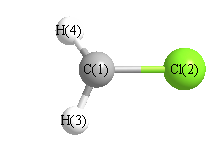Jump to
S1C2
Energy calculated at CCSD(T)/TZVP
| | hartrees |
|---|
| Energy at 0K | -498.801512 |
| Energy at 298.15K | |
| HF Energy | -498.500022 |
| Nuclear repulsion energy | 45.020255 |
The energy at 298.15K was derived from the energy at 0K
and an integrated heat capacity that used the calculated vibrational frequencies.
Vibrational Frequencies calculated at CCSD(T)/TZVP
| Mode Number |
Symmetry |
Frequency
(cm-1) |
Scaled Frequency
(cm-1) |
IR Intensities
(km mol-1) |
Raman Act
(Å4/u) |
Dep P |
Dep U |
|---|
| 1 |
A' |
3200 |
3080 |
|
|
|
|
| 2 |
A' |
1456 |
1401 |
|
|
|
|
| 3 |
A' |
835 |
803 |
|
|
|
|
| 4 |
A' |
258 |
249 |
|
|
|
|
| 5 |
A" |
3352 |
3227 |
|
|
|
|
| 6 |
A" |
1023 |
984 |
|
|
|
|
Unscaled Zero Point Vibrational Energy (zpe) 5061.7 cm
-1
Scaled (by 0.9625) Zero Point Vibrational Energy (zpe) 4871.9 cm
-1
See section
III.C.1 List or set vibrational scaling factors
to change the scale factors used here.
See section
III.C.2
Calculate a vibrational scaling factor for a given set of molecules
to determine the least squares best scaling factor.
Geometric Data calculated at CCSD(T)/TZVP
Point Group is Cs
Cartesians (Å)
| Atom |
x (Å) |
y (Å) |
z (Å) |
|---|
| C1 |
-0.009 |
1.130 |
0.000 |
| Cl2 |
-0.009 |
-0.590 |
0.000 |
| H3 |
0.102 |
1.624 |
0.951 |
| H4 |
0.102 |
1.624 |
-0.951 |
Atom - Atom Distances (Å)
| |
C1 |
Cl2 |
H3 |
H4 |
| C1 | | 1.7195 | 1.0775 | 1.0775 |
Cl2 | 1.7195 | | 2.4122 | 2.4122 | H3 | 1.0775 | 2.4122 | | 1.9017 | H4 | 1.0775 | 2.4122 | 1.9017 | |
 More geometry information
More geometry information
Calculated Bond Angles
| atom1 |
atom2 |
atom3 |
angle |
|
atom1 |
atom2 |
atom3 |
angle |
| Br2 |
C1 |
H3 |
117.325 |
|
Br2 |
C1 |
H4 |
117.325 |
| H3 |
C1 |
H4 |
123.878 |
|
Electronic energy levels
Charges, Dipole, Quadrupole and Polarizability
Jump to
S1C1
Energy calculated at CCSD(T)/TZVP
| | hartrees |
|---|
| Energy at 0K | -498.801489 |
| Energy at 298.15K | |
| HF Energy | -498.499898 |
| Nuclear repulsion energy | 45.038939 |
The energy at 298.15K was derived from the energy at 0K
and an integrated heat capacity that used the calculated vibrational frequencies.
Vibrational Frequencies calculated at CCSD(T)/TZVP
| Mode Number |
Symmetry |
Frequency
(cm-1) |
Scaled Frequency
(cm-1) |
IR Intensities
(km mol-1) |
Raman Act
(Å4/u) |
Dep P |
Dep U |
|---|
| 1 |
A1 |
3205 |
3084 |
|
|
|
|
| 2 |
A1 |
1456 |
1402 |
|
|
|
|
| 3 |
A1 |
837 |
805 |
|
|
|
|
| 4 |
B1 |
184i |
177i |
|
|
|
|
| 5 |
B2 |
3359 |
3233 |
|
|
|
|
| 6 |
B2 |
1019 |
981 |
|
|
|
|
Unscaled Zero Point Vibrational Energy (zpe) 4846.0 cm
-1
Scaled (by 0.9625) Zero Point Vibrational Energy (zpe) 4664.3 cm
-1
See section
III.C.1 List or set vibrational scaling factors
to change the scale factors used here.
See section
III.C.2
Calculate a vibrational scaling factor for a given set of molecules
to determine the least squares best scaling factor.
Geometric Data calculated at CCSD(T)/TZVP
Point Group is C2v
Cartesians (Å)
| Atom |
x (Å) |
y (Å) |
z (Å) |
|---|
| C1 |
0.000 |
0.000 |
-1.128 |
| Cl2 |
0.000 |
0.000 |
0.590 |
| H3 |
0.000 |
0.953 |
-1.629 |
| H4 |
0.000 |
-0.953 |
-1.629 |
Atom - Atom Distances (Å)
| |
C1 |
Cl2 |
H3 |
H4 |
| C1 | | 1.7181 | 1.0770 | 1.0770 |
Cl2 | 1.7181 | | 2.4152 | 2.4152 | H3 | 1.0770 | 2.4152 | | 1.9067 | H4 | 1.0770 | 2.4152 | 1.9067 | |
 More geometry information
More geometry information
Calculated Bond Angles
| atom1 |
atom2 |
atom3 |
angle |
|
atom1 |
atom2 |
atom3 |
angle |
| Br2 |
C1 |
H3 |
117.719 |
|
Br2 |
C1 |
H4 |
117.719 |
| H3 |
C1 |
H4 |
124.562 |
|
Electronic energy levels
Charges, Dipole, Quadrupole and Polarizability
